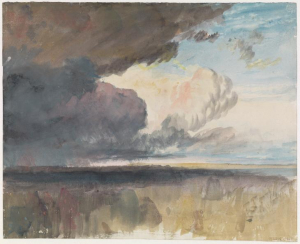MONTHLY BLOG 152, SHORT AND CHEERFUL MEDITATIONS UPON RETURNING TO LIVE IN A (currently) TEMPERATE CLIMATE
If citing, please kindly acknowledge copyright © Penelope J. Corfield (2023)

|
Rainclouds Approach over a Landscape, (painted c.1822-40) |
Returning from great heat of Rome to live in a temperate climate has made me appreciate the great merits of fresh cool air, breezes, rain, and clouds, as never before.
First of all: fresh cool air. Breathe deeply. Wonderful. As a Danish proverb observes: ‘Fresh air impoverishes the doctor’.
Then breezes and wind: anything from the lightest zephyr to tempestuous gales. It’s great fun walking along with a brisk wind propelling the body forwards; and it’s equally fun making the return journey, leaning into a strong head-wind and taking huge gulps of bracing air.
I also love the sound of a breeze in the trees, rustling the leaves. And the sight of trees and bushes dancing exuberantly in swirling currents of air. ‘Who has seen the wind? Neither you nor I./ But when the trees bow down their heads,/ The wind is passing by’.1
And then there’s the exhilaration of a true gale. ‘O wild West Wind’, as Shelley began one of his most startling Odes.2 He heard majesty in the tumult of the Autumnal storm’s ‘mighty harmonies’. And he saw nature’s ferocious power as both destroyer and preserver. ‘If Winter comes, can Spring be far behind?’
Plus there’s rain: everything from the lightest mist with the unstrained qualities of mercy: ‘which droppeth, like the gentle rain, from heaven’;3 through to the heaviest, most relentless downpour. All forms of water cascading downwards towards the earth have their own fascination. And – if suitably dressed for the experience – it’s great to go walking (let alone dancing or singing) in the rain. By the way, my partner Tony and I were hitching across the Algerian Sahara in the summer of 1966 (yes, it’s true!), when there was a sudden thunderstorm with a massive downpour. Laughing idiotically, we immediately ran outside to dance in the rain. Very liberating. The local people were disbelieving but kindly let us back indoors afterwards, to get dry.
Which leaves clouds. They are ever-entrancing. Changing colours and shape; appearing and disappearing; covering the sun and then parting to reveal its rays. The only permutation that I don’t like are low grey clouds that cover the whole sky and refuse to part for days (sometimes even for weeks) on end. They don’t release rain; they lurk; and they don’t seem to move. Come on, wind! Blow these recalcitrant sun-blockers away!
But, upon my return from Rome, I found myself walking under such a low grey cloud-cover with fresh appreciation. The air was completely quiet and still, and the ghostly grey light was magical. It would not do for ever … but then, in Britain’s changeable weather, nothing does last for that long.
So three cheers for life in a temperate climate, with ever-changing weather. As long as that basic pattern holds. The current surge in global warming is endangering all established norms of global climate world-wide. Time for urgent remedial work – by everyone from governments and international organisations to all individuals, whether today experiencing sunshine or clouds.4 Action stations! A happily habitable Planet Earth is far too good to miss!
ENDNOTES:
1 C.G. Rossetti (1830-94), ‘Who Has Seen the Wind?’ first publ. in Sing-Song: A Nursery Rhyme Book (1872).
2 P.B. Shelley (1792-1822), Ode to the West Wind (written 1819; first pub. 1820).
3 Portia’s speech in W. Shakespeare (1564-1616), The Merchant of Venice (written late 1590s; 1st pub. 1600), Act IV, sc.1.
4 See e.g. J. Gale, The Sustainable(ish) Living Guide: Everything Yu Need to Know to Make Small Changes that Make a Big Difference (2020); and K. Hayhoe, Saving Us: A Climate Scientist’s Case for Hope and Healing in a Divided World (2021).
For further discussion, see Twitter
To read other discussion-points, please click here
To download Monthly Blog 152 please click here


